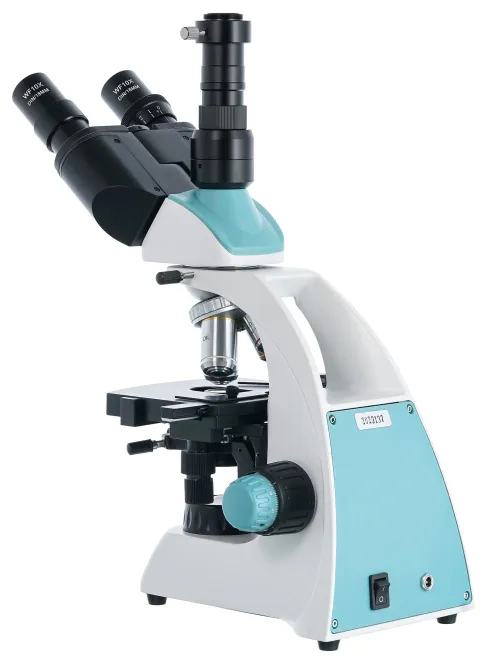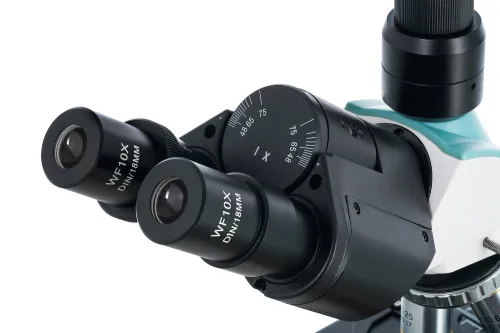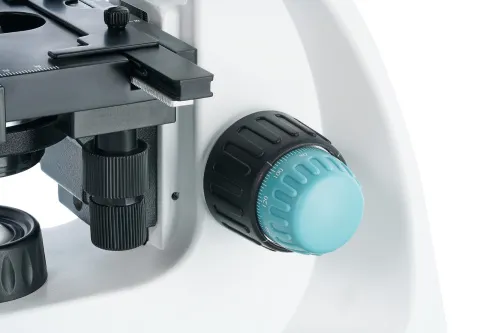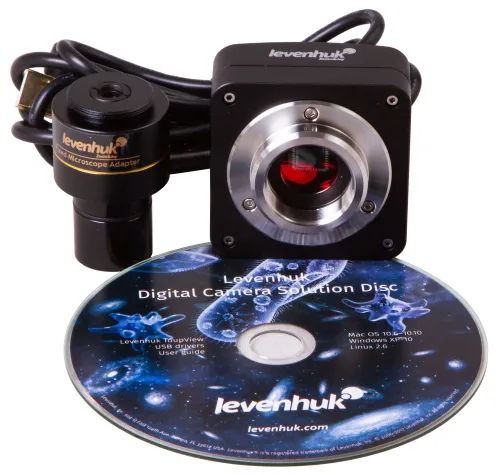Levenhuk D400T Digital Trinocular Microscope
Magnification: 40–1000x. Trinocular head, achromatic objectives, LED illumination with a collector lens
| Product ID | 75435 |
| Brand | Levenhuk, Inc., USA |
| Warranty | lifetime |
| EAN | 5905555005270 |
| Package size (LxWxH) | 42x21x29 cm |
| Shipping Weight | 4.16 kg |
The Levenhuk D400T is a digital biological microscope with a 3.1MP camera included in the kit. This instrument can be used for visual observations as well as photographing samples, video shooting, and transmitting the image to the screen. The image resolution reaches 2048х1536 pixels. This microscope is a great choice for a laboratory, veterinary office, or educational institution.
It features a trinocular head. The visual module is inclined, which prevents tensing your neck muscles up during long hours of observations. The eyepiece tube for a digital camera (included) is vertical. The kit includes two wide-field eyepieces with 10x magnification. The optical system includes two wide-field eyepieces with 4x, 10x, 40x, and 100x magnification. The front lenses of the 40x and 100x objectives are equipped with protective spring-loaded frames. Moreover, a 100x objective lens can be used for oil immersion.
There is a mechanical scale for fixing microscope slides. A bright LED light and collector lens are located at the bottom. The illumination brightness is adjustable. The light system also includes an Abbe condenser with an iris diaphragm that allows for adjusting luminous intensity. You can utilize light filters with this microscope.
The digital camera (included) comes with the software for it. It allows you to edit previously saved images: zoom them, crop them, change the contrast and brightness, and so forth.
Note: Remember that the power supply in the US and Canada is 110V, and it is 220–240V in most European countries. Please refer to the specifications table for the correct voltage and never attempt to plug a 110V device into a 220V outlet and vice versa without using a converter.
Some things that you can see under a microscope:





You can find these and many more interesting microscope slides to observe in the Levenhuk Prepared Slides Sets.
The Levenhuk D400T Digital Trinocular Microscope is compatible with Levenhuk digital cameras (additional cameras are purchased separately). Levenhuk cameras are installed in an eyepiece tube instead of an eyepiece.
Main Features:
- Wide-field achromatic optics
- Magnification: 40–1000x
- Lower LED lighting for observations in transmitted light
- Collector and brightness adjustment, power supply by batteries or AC power supply
- 3.1MP digital camera is included
The kit includes:
- Microscope
- Achromatic objective lenses: 4x, 10x, 40x, and 100x (oil immersion)
- WF10x/18mm eyepieces (2 pcs)
- Abbe condenser N.A. 1.25 with an iris diaphragm and filter holder
- Charging power cord
- C-mount
- Vial of immersion oil
- Filters: blue, green, yellow
- Dust cover
- Digital camera
- Camera adapter
- USB cable for the camera
- Software CD
- User manual and lifetime warranty
| Product ID | 75435 |
| Brand | Levenhuk, Inc., USA |
| Warranty | lifetime |
| EAN | 5905555005270 |
| Package size (LxWxH) | 42x21x29 cm |
| Shipping Weight | 4.16 kg |
| Type | biological, light/optical, digital |
| Microscope head type | trinocular |
| Optics material | optical glass |
| Head | 360 ° rotatable |
| Head inclination angle | 30 ° |
| Magnification, x | 40 — 1000 |
| Eyepiece tube diameter, mm | 23.2 |
| Eyepieces | WF10x/18mm (2 pcs.) |
| Objectives | achromatic: 4x, 10x, 40xs, 100xs (oil immersion) |
| Revolving nosepiece | for 4 objectives |
| Interpupillary distance, mm | 48 — 75 |
| Stage, mm | 115x110 |
| Stage moving range, mm | 55/20 |
| Stage features | mechanical double-layer |
| Eyepiece diopter adjustment, diopters | ±5 |
| Condenser | Abbe N.A. 1.25 with an iris diaphragm and filter holder |
| Diaphragm | iris |
| Focus | coaxial, coarse (12mm) and fine (0.002mm) |
| Body | metal |
| Illumination | LED |
| Brightness adjustment | ✓ |
| Power supply | 110–220V, via AC adapter (included), 3 AA batteries (not included) |
| Power supply: batteries/built-in battery | yes |
| Light source type | with a collector, 1W LED |
| Light filters | blue, green, yellow |
| User level | experienced users |
| Assembly and installation difficulty level | easy |
| Software language | Mac and Linux: English, Windows: English, Russian, French, German, Polish, Chinese, Turkish |
| Application | laboratory/medical |
| Illumination location | lower |
| Research method | bright field |
| Digital camera included | ✓ |
| Pouch/case/bag in set | dust cover |
| Maximum resolution | 2048x1536 |
| Megapixels | 3.1 |
| Sensor element | 1/2" |
| Pixel size, μm | 3.2x3.2 |
| Video recording | yes |
| Image format | *.jpg, *.bmp, *.png, *.tif and others |
| Video format | output: *.wmv, *.avi, *.h264 (Windows 8 and later), *h265 (Windows 10 and later) |
| Spectral range, nm | 400–650 |
| White balance | automatic, manual |
| Exposure control | automatic, manual |
| Sensitivity, V/lux-sec@550nm | 1.5 |
| Frame rate | up to 11 frames per second |
| Dynamic range, dB | 75 |
| Usage location | eyepiece tube (replaces an eyepiece) |
| Method of exposure | ERS (Electronic Rolling Shutter) |
| Software, drivers | LevenhukLite |
| Programmable options | brightness, exposure control, image size |
| Output | USB 2.0 |
| System requirements | Windows 8/10/11 (32bit and 64bit), Mac OS X, Linux, up to 2.8GHz Intel Core 2 or higher, minimum 2GB RAM, USB 2.0 port, CD-ROM |
| Camera power supply | via USB cable |
We have gathered answers to the most frequently asked questions to help you sort things out
Find out why studying eyes under a microscope is entertaining; how insects’ and arachnids’ eyes differ and what the best way is to observe such an interesting specimen
Read this review to learn how to observe human hair, what different hair looks like under a microscope and what magnification is required for observations
Learn what a numerical aperture is and how to choose a suitable objective lens for your microscope here
Learn what a spider looks like under microscope, when the best time is to take photos of it, how to study it properly at magnification and more interesting facts about observing insects and arachnids
This review for beginner explorers of the micro world introduces you to the optical, illuminating and mechanical parts of a microscope and their functions
Short article about Paramecium caudatum - a microorganism that is interesting to observe through any microscope
















